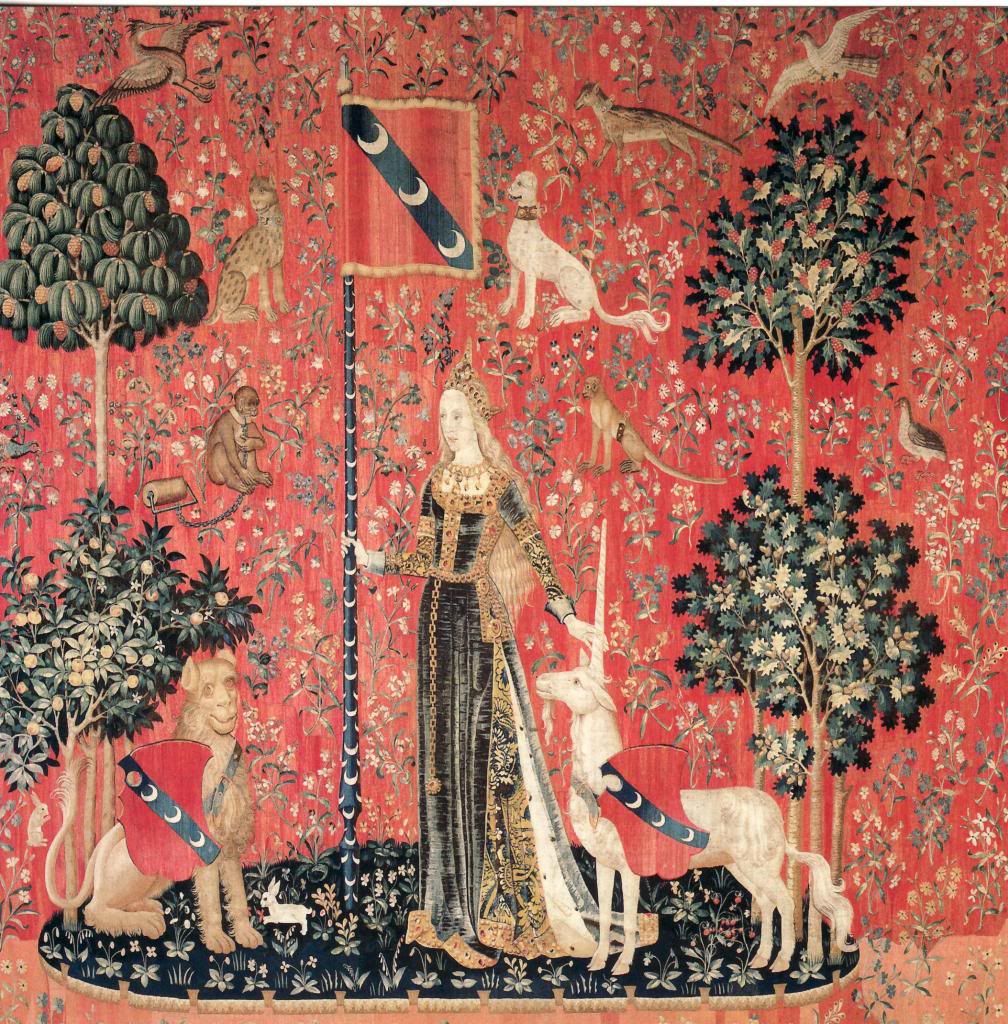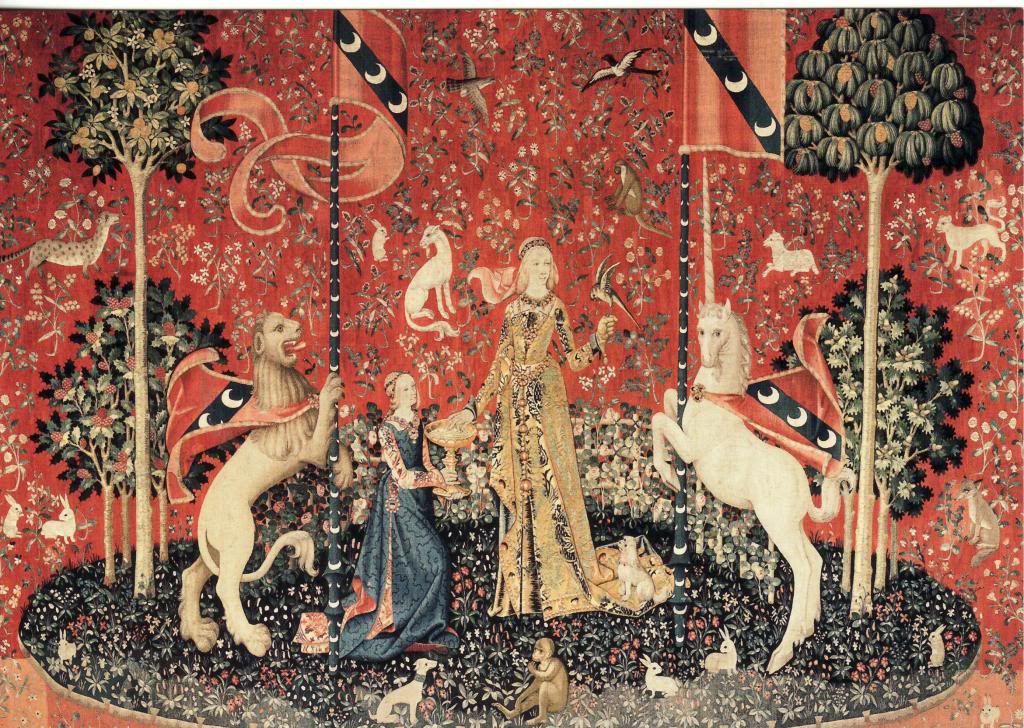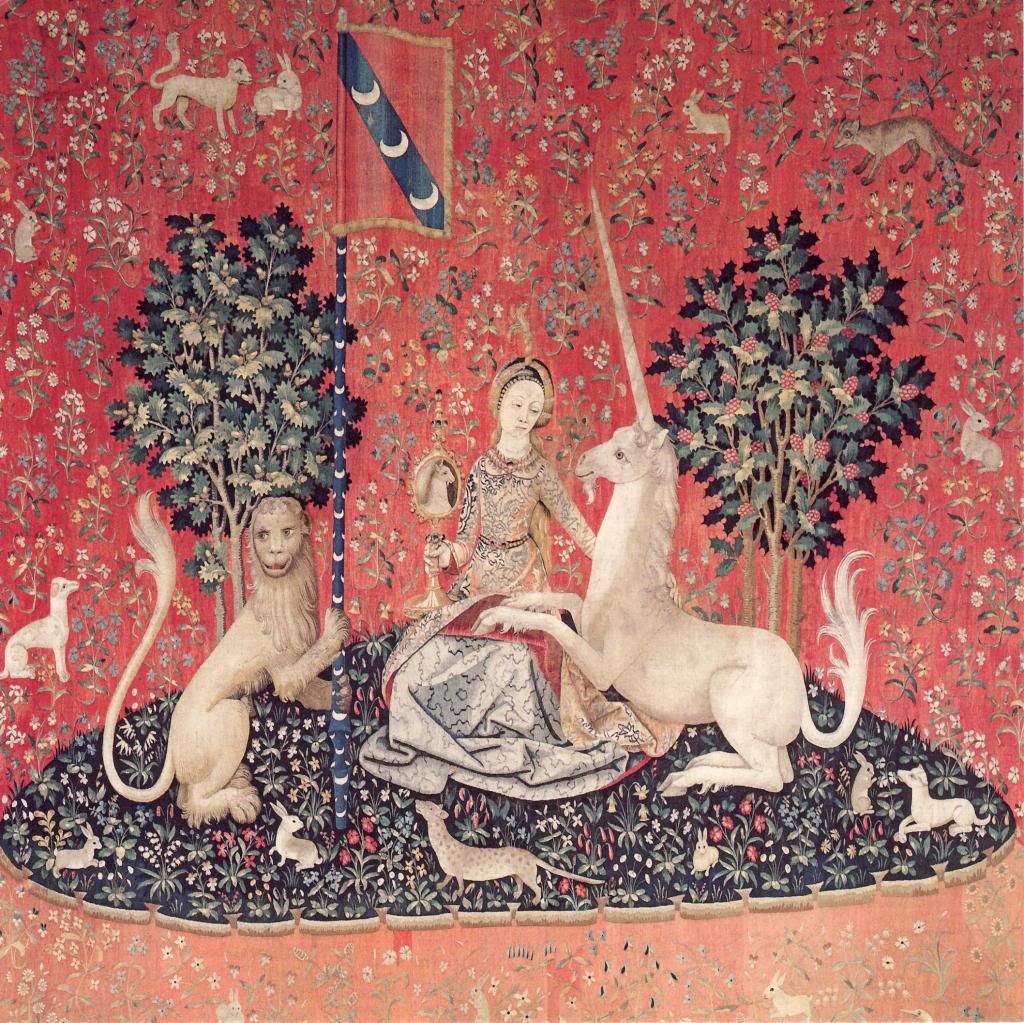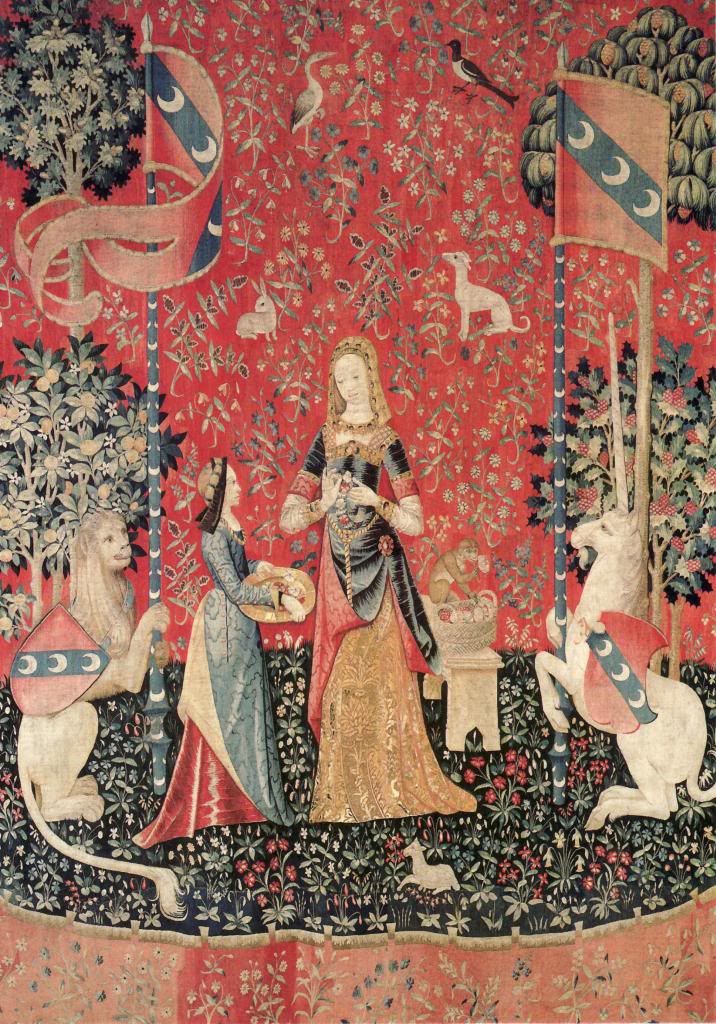During my recent trip to France I bought some postcards. I will show them to you :)
So, the first six show tapesties that I saw in the Museum of the Middle Age, the whole cycle is commonly called "The Lady and the Unicorn".
The Lady and the Unicorn (French: La Dame à la licorne) is the modern title given to a series of six tapestries woven in Flanders of wool and silk, from designs ("cartoons") drawn in Paris in the late fifteenth century. The suite, on display in the Musée du Moyen-Âge, is often considered one of the greatest works of art of the Middle Ages in Europe.
Five of the tapestries are commonly interpreted as depicting the five senses – taste, hearing, sight, smell, and touch. The sixth displays the words "À mon seul désir". The tapestry's meaning is obscure, but has been interpreted as representing love or understanding. Each of the six tapestries depicts a noble lady with the unicorn on her left and a lion on her right; some include a monkey in the scene. The pennants, as well as the armor of the Unicorn and Lion in the tapestry bear the arms of the sponsor, Jean Le Viste, a powerful nobleman in the court of King Charles VII.
The tapestries are created in the style of mille-fleurs (meaning: "thousand flowers").
The tapestries were rediscovered in 1841 by Prosper Mérimée in Boussac castle (owned at the time by the subprefect of the Creuse) where they had been suffering damage from their storage conditions. Novelist George Sand brought public attention to the tapestries in her works at the time. The cycle is currently held in the Musée de Cluny (Musée du Moyen-Âge), Paris (France), where it has resided since 1882.
Taste
The lady is taking sweets from a dish held by a maidservant. Her eyes are on a parakeet on her upheld left hand. The lion and the unicorn are both standing on their hind legs reaching up to pennants that frame the lady on either side. The monkey is at her feet, eating one of the sweetmeats.
The lady plays a portative organ on top of a table covered with a Turkish rug. Her maidservant stands to the opposite side and operates the bellows. The lion and unicorn once again frame the scene holding up the pennants. Just as on all the other tapestries, the unicorn is to the lady's left and the lion to her right - a common denominator to all the tapestries.
Sight
The lady is seated, holding a mirror up in her right hand. The unicorn kneels on the ground, with his front legs in the lady's lap, from which he gazes at his reflection in the mirror. The lion on the left holds up a pennant.

This tapestry has elicited a number of interpretations. One interpretation sees the lady putting the necklace into the chest as a renunciation of the passions aroused by the other senses, and as an assertion of her free will. Another sees the tapestry as representing a sixth sense of understanding (derived from the sermons of Jean Gerson of the University of Paris, c. 1420). Various other interpretations see the tapestry as representing love or virginity. It is also debated whether the lady in "À Mon Seul Désir" is picking up or setting aside the necklace.
So, the first six show tapesties that I saw in the Museum of the Middle Age, the whole cycle is commonly called "The Lady and the Unicorn".
The Lady and the Unicorn (French: La Dame à la licorne) is the modern title given to a series of six tapestries woven in Flanders of wool and silk, from designs ("cartoons") drawn in Paris in the late fifteenth century. The suite, on display in the Musée du Moyen-Âge, is often considered one of the greatest works of art of the Middle Ages in Europe.
Five of the tapestries are commonly interpreted as depicting the five senses – taste, hearing, sight, smell, and touch. The sixth displays the words "À mon seul désir". The tapestry's meaning is obscure, but has been interpreted as representing love or understanding. Each of the six tapestries depicts a noble lady with the unicorn on her left and a lion on her right; some include a monkey in the scene. The pennants, as well as the armor of the Unicorn and Lion in the tapestry bear the arms of the sponsor, Jean Le Viste, a powerful nobleman in the court of King Charles VII.
The tapestries are created in the style of mille-fleurs (meaning: "thousand flowers").
The tapestries were rediscovered in 1841 by Prosper Mérimée in Boussac castle (owned at the time by the subprefect of the Creuse) where they had been suffering damage from their storage conditions. Novelist George Sand brought public attention to the tapestries in her works at the time. The cycle is currently held in the Musée de Cluny (Musée du Moyen-Âge), Paris (France), where it has resided since 1882.
Taste
The lady is taking sweets from a dish held by a maidservant. Her eyes are on a parakeet on her upheld left hand. The lion and the unicorn are both standing on their hind legs reaching up to pennants that frame the lady on either side. The monkey is at her feet, eating one of the sweetmeats.
The lady plays a portative organ on top of a table covered with a Turkish rug. Her maidservant stands to the opposite side and operates the bellows. The lion and unicorn once again frame the scene holding up the pennants. Just as on all the other tapestries, the unicorn is to the lady's left and the lion to her right - a common denominator to all the tapestries.
Sight
The lady is seated, holding a mirror up in her right hand. The unicorn kneels on the ground, with his front legs in the lady's lap, from which he gazes at his reflection in the mirror. The lion on the left holds up a pennant.
- Smell

- Touch
- À Mon Seul Désir
This tapestry has elicited a number of interpretations. One interpretation sees the lady putting the necklace into the chest as a renunciation of the passions aroused by the other senses, and as an assertion of her free will. Another sees the tapestry as representing a sixth sense of understanding (derived from the sermons of Jean Gerson of the University of Paris, c. 1420). Various other interpretations see the tapestry as representing love or virginity. It is also debated whether the lady in "À Mon Seul Désir" is picking up or setting aside the necklace.





No comments:
Post a Comment